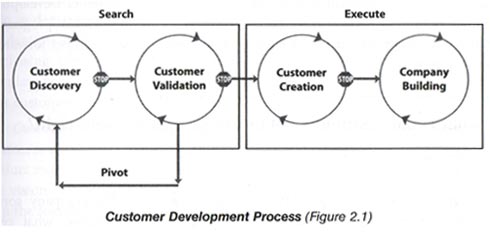
10 Places to Sell Your Online Course
If you don’t want to spend as much time and money marketing your course, you can always try to sell your content on course marketplaces with existing audiences. Here are 10 you may want to consider.

There are lots of ways to go about developing an online course but traditional models often follow the following general steps:
This general outline seems logical enough. After all, it is probably what most teachers, professors, and learning institutions generally follow.
But there is one massive problem:
There is no input from potential customers.
The traditional product model operates on the presumption that if you simply execute your plan well, your course will succeed in the market.
However, that assumption is simply a guess that isn’t supported by any real market data.
In other words, what evidence do you have that the course will be successful?
A product sells because it meets the needs and demands of the market (potential customers) at the price offered. It is something the market wants and is willing to pay for.
But if you build a course without knowing what the market is willing to pay for, how can you be certain you have truly made something that meets a need you aren’t even aware of?
Fortunately, there is a more strategic way.
What if you could build a course like a scientist tests a theory?
A scientists starts with an hypothesis (an idea or semi-educated guess) about how reality works. Then, he conducts tests to see if his hypothesis is true. Along the way, he lets the data prove, disprove, or shape his original hypothesis. He will not assume his hypothesis is correct until enough tests are done to verify it.
Fortunately, the same approach can be used in creating an online course. Instead of making a wild guess at what the market wants and hope everything works out, you can follow a more scientific method with less risk and based feedback from potential customers as you develop.
For the purpose of this article, we are going to adapt the Customer Development model of product creation as explained by Steve Blank and Bob Dorf in their excellent book, The Startup Owner’s Manual.1 It is a model that places customer needs and wants central to the development process rather than just the ideas of the course creator.
Here are the basics of the customer development model’s steps:

Notice how the first three steps are all focused on the customer. The entire development process is driven by what the customer wants as proven by what the customer purchases and the feedback given.
The arrows going around each circle indicate a continuous process of revision based on market testing and feedback.
Here is a simplified overview of how the customer development model could be adapted to online course creation:
Notice how in this process, the idea starts small and must pass market testing before more time and money is spent developing a larger product.
When a larger product is developed, it is again put through tests with a small marketing budget to collect feedback. Not until the product has been fully tested and revised do you invest large amounts of money marketing it.
This entire process lowers risk and gives a course the very best chances possible to succeed based on true market feedback.
Let’s go into a bit more detail about how this might work with a course idea. This process generally follows the principles and steps outlined in The Startup Owner’s Manual. The steps below are simplified from what you will find in the book and some steps are left out. We recommend buying the book and working through it yourself and making your own adjustments to your particular situation.
We will now walk through a course creation process using a made up idea to see how a market might react to the initial idea and what changes need to made along the way.
The core question I need to answer: “Is there a problem enough people will pay me to solve?”
Let’s say I have a passion for entrepreneurship and I have an idea about developing a course teaching people how to start an online business from home.
The basis of the idea comes from news reports I have read about how more and more Americans are starting their own businesses and desiring to leave the corporate world and experience more personal freedom. Since I have experience in this field, I feel I have something to offer.
I believe that an online business is the most risk-free and has the highest potential to succeed for most people. I will focus on teaching solo entrepreneurs the basics of starting a small online business.
My initial hypothetical target audience:
My initial product idea:
In this step I need to gather all the data I can to determine the true size of the market so I can make an educated guess at the potential number of paying customers.
Demographic Research
First, I will find statistics on how many small businesses are started every year in America from sources like the Small Business Administration and any reliable sources that have interpreted this data. I will also look for any reports from trade and industry groups or news articles commenting on paid research that has been done on this topic.
Next, I will see if I can find out what percentage of these small businesses are online and started by one person. I will also try to find any demographic information (gender, age, marital status, etc.), and what percentage of these businesses actually succeed, so I can use this information in my marketing.
Let’s say from my research I discover that there is a large number of online businesses being started by college graduates right out of school (say 20%) and that there is a slightly higher percentage of females starting businesses than males (52% to 48%). Most new businesses are started by people age 45 and under. Also, there tends to be a higher percentage of singles than married people and that roughly 20% of the 627,000 new businesses that are started each year are online. I was not able to find out how many of those are sole entrepreneurs or what types of companies they are coming from.
After my research, I decide to revise my initial demographic profile to the following:
My hypothetical target audience demographics:
Psychographic Data Research
Next, I want to find out as much psychographic data as I can. Psychographics are the internal reasons why someone might want to purchase my product. This includes their motivations, desires, goals, etc. – basically any internal factor that might influence a decision to purchase.
To get initial psychographic data, I search the following:
To help me with all the data to sort through, I decide to hire a researcher on Upwork to go through Amazon reviews and write down any comments from readers that might help me gain insight into what they liked or didn’t like about the book and what questions or problems were (or still are) troubling them.
From my initial psychographic data research I discover the following:
Based on my research, I believe I can now construct an initial value proposition hypothesis (how I plan on solving customer problems).
Value proposition hypothesis:
Competitor Research
I also need to conduct research on existing competition to find out the following:
As I start my competitor research, I start to feel overwhelmed at all the competition. I decide to hire a researcher from Upwork again with specific instructions on what to note about competition and submit findings to me in a spreadsheet for my review.
At the end of my competition research, I come to a terrible conclusion:
There is a lot of existing competition!
Unfortunately, there are a lot of competitors offering courses for much lower costs ($100-$300 range) than I plan on offering. This severely undercuts my pricing strategy.
What should I do?
I decide that I don’t want to compete in the low price range as it doesn’t give me enough profit margin to spend on marketing. Instead, I decide to do the following:
I may have to do more to increase the perceived value of my course against the lower priced competitors but I want to test these value added offers first to see if they are sufficient.
Instead of spending a large amount of time and money developing the course, I now need to create a small test product to get initial feedback from a group of potential customers.
This test product needs to demonstrate that I understand the core problem(s) of my target audience and that I have a solution that the market is willing to pay for.
What I decide to do is create a paid, 1.5 hour webinar that walks people through how to create a business plan for an online business. I will talk them through all the basics steps from market research to constructing a viable business model to creating an exit strategy for a future sale. At the end, I will provide them with a visual worksheet they can fill out on their own that will serve as a roadmap to guide them in their journey.
The webinar will cost $100 and all paying customers will also receive a $100 discount coupon off any future courses I develop. I believe if I can get at least 100 people to pay for this webinar, it will be a good sign that my idea has some market viability.
Assuming a 1-2% conversion rate, I will need to send 5,000-10,000 visitors to my webinar landing page in order to get 100 paying signups via paid advertising or any free promotional methods I can come up with. Any who do not purchase the webinar I will aggressively attempt to sign up for my email list so I can contact them again in the future.
Additionally, I will use the webinar to collect any questions viewers have about my presentation. I will use those questions as content ideas during course development.
At the end of the webinar, I will pitch a pilot version of my course. I will ask all customers who pay for the pilot version to provide feedback every step of the way on what questions they have, what content I need to add, what I need to clarify, and how easy the course delivery technology is to use.
The cost of the pilot program will be $499 (half the price I wish to charge in the future). Additionally, if customers complete all the feedback I ask of them, I will refund another 50% of what they paid ($249). All who complete the feedback will basically get the course for 75% off. I will also let them have access to any future versions of the course at no cost.
If I can get at least 25 people from the webinar or other marketing I do to pay for the pilot course, I will consider that another successful test of my idea.
From the webinar, I was only able to get 10 people to sign up for the pilot course. However, I was able to get 500 people to sign up to my email list from my initial promotion. I sent those 500 the offer to join my pilot course and was able to get 10 more people to pay for the pilot. Through paid advertising, I gained another 5 customers. I am now ready to create the pilot course.
The advantage of a pilot course is the ability to gauge feedback and to actually get your students to help you build the course.
How do you do that? You simply put together a rough outline of the course curriculum and then ask your students for feedback and what additional topics they want to learn.
Lexi Rodrigo, in her excellent post on how to create a pilot course, suggests creating one module per week and collecting student feedback as you go. You then fill out your course module content based on what your pilot students are telling you about what they want to learn, what they need more explanation about, and so on.
I go through the entire pilot course and collect student feedback along the way. I also ask them some important questions at the end of the course about their likelihood to purchase the course at full price.
Unfortunately, the feedback I collect reveals I have made a very serious mistake.
Course Correction – Fixing a Serious Mistake
From my pilot course feedback, I realize a very big problem:
Even though my students really like the ideas and business plan they are creating, they are not confident they can follow my course and create a viable online business in six months let alone a year. On the exit survey I gave them, only 1 out of the 20 would be confident enough to quit their current job and be willing to try this business venture without guaranteed replacement income within a year. The other five, who are fresh out of college, did not show a high degree of confidence they could get a full time income within a year. Two were willing to work part time at a job and devote the rest of their time to working on their idea.
Basically, only 3 out of 25 had any confidence of creating a full time income stream within a year.
That is a terrible percentage. What am I going to do? Is my whole business plan ruined?
Let’s take a step back for a moment and analyze what is happening.
Here’s the source of the problem, my initial hypothesis included the following:
“Financial situation: varies, but I still hypothesize people have 6 months max if they are leaving a prior job. A new college graduate may have lower living costs and may have longer. However, they also may not have the money to pay what I am charging.”
My problem: I did not do enough research to validate my hypothesis concerning my target audience’s financial situation.
I’ve got to find a solution to this problem right away.
I decide to survey my target demographic with Google Adwords and Facebook ads. I send the traffic to a landing page that explains the course and then surveys the visitors. One of the questions on the survey is, “If you quit your job today, how long could you live on your current savings to work on a new business venture?” I incentivize all survey participants with a $100 discount on my future course and get a 10% response rate of the 2,000 visitors I paid for via ads. Out of the 200 I discover the following:
On average, my 200 visitors only had 1-2 months of savings to live to support work on a new business venture. 1-2 months. My plan is in serious trouble.
Even worse, I discover that I could have found out how much the average American has in their savings account by age range and demographic profile from an already existing survey from Bankrate. Not only did I spend $1,000 on information I could have got for free, I greatly overestimated the amount of time someone would have to start a new online business.
How to Pivot and Not Give Up
When you make mistakes like this in business, your courage sinks. You start to wonder if you are truly cut out for entrepreneurship. Your confidence is in the toilet.
But here is some great news – the Customer Development Model EXPECTS you to make mistakes!
Here is a dose of reality – everyone makes mistakes. Everyone. There isn’t a single business man or woman alive who doesn’t make mistakes. From Warren Buffet to the smartest business person in your town, they all make mistakes.
The trick is making the right mistakes that don’t sink you and actually lead to greater success in the process.
The great thing about the Customer Development model is that I learned about this mistake BEFORE I created the final version of the course and dumped a ton of money into marketing. That means I still have a chance and not all is lost.
I realize that marketing this course as a full-time income replacement plan in six months is unfeasible for most people and probably unrealistic for anyone just starting out.
So I need to change my course name to the following:
Working to Freedom: How to Create a Side Hustle Business You Can Turn Into Full Time Income Within 2 Years or Less.
What I need to do is adapt my course content to appeal to someone who has a limited amount of time per week pursuing this venture. This shouldn’t be a problem because there is no real rush to most of the steps I am teaching. Most people can work on this at their own pace.
However, it does mean I need to shift my demographic profile a bit. Someone who is already working 50+ hours a week with family obligations is probably not going to have much time at all to spend developing a new business. I must either market the course towards people who do have the time or can renegotiate their schedule to work less.
My job now is to come up with a minimum amount of time per week I think someone can work on this new business road map. That means that someone right out of college may have more time than someone who is two decades into their career.
However, the trade off is that someone right out of college may not have the money to pay what I am charging. There is now a perceived mismatch between my natural target audience (those with more time) and those who can pay (those with less time). So what do I do?
I can either lower the price of the course (which I don’t want to do) or I can think of other options.
I will offer a payment plan.
Someone may not be able to afford $999 upfront, but they may be able to afford it over 6 months at $100/month.
Also, I might want to explore offering discounts for students who are willing to give me something in return (maybe some additional feedback, market research, social media promotion, etc.).
Here’s the important lesson:
When you feel like you are stuck and have hit a wall, don’t give up. There are ALWAYS solutions to just about every problem.
Now what I have to do is test my new hypothesis, pricing, and marketing strategy.
The next thing I do is create the first version of a full course based on my pilot student feedback while revising it to fit a time commitment of about 5 hours per week.
I then market to the course to those interested in creating a side hustle (part time business) that eventually will become a full time business.
Since this is the first time I am marketing the full course, the best thing to do is start with a small group of customers and once more collect feedback.
So I decide to limit the initial launch to 100 students. This isn’t a “fake scarcity” ploy used by some course creators. For the next 1-2 months, I only want to focus on interacting with these 100 students to learn all I can from them to revise the course.
Doing this will also allow me to limit my initial marketing spend.
From this 100 students, I learn even more valuable feedback and once more revise the course. I learn I need to add some encouragements and progress indicators to help students work consistently through the material and not give up.
I also discover more areas where my instruction wasn’t clear enough, more questions and concerns I can address, and where I should add some detailed demonstrations of how to do certain tasks.
Before scaling the course even larger, I decide to run one more test group through the course to collect feedback. This time, I decide to sell the course to 300 students via paid advertising and free promotional methods.
To serve this large of an audience, I decide to hire a part time assistant via Upwork to help manage student questions and feedback.
Once more, I make revisions to the core course after enough of this batch of students completes the steps. Based on the feedback I am getting, students are really liking what I am offering. I am now ready for a another revision followed by a full launch with no student limitations.
To handle a larger number of students, I decide to hire my assistant full time to handle customer service. I also decide to spend half of my previous earnings on marketing the course since I have a good idea of what I need to pay in order to get a customer. I know that my customer acquisition costs are fairly low in relation to what I am generating in revenue.
At this point, I focus on gaining more students and making sure my technology, customer service, and feedback collection systems can handle the growth. I will need to continually test marketing messages, pricing, and listen to as much feedback as possible to make sure I am meeting student needs.
And one other great bonus from all the feedback I am collecting? I am learning about more student problems with which I can create more courses in the future!
Though this was a hypothetical thought experiment on how to create an online course using a market driven approach, I hope you can see the value of following a model like this.
If you stay focused on the needs of your market from the beginning and throughout the process, you have a much higher chance of succeeding and lowering the cost and risk in developing your course.
Helpful Resource – Course Creation Guides
Blank, Steve and Bob Dorf. The Startup Owner’s Manual. Pescadero, CA: K&S Ranch Publishers Inc., 2012.
Rodrigo, Lexi. “7 Steps to Create an Online Course (That Doesn’t Suck),” Mirasee, https://mirasee.com/blog/how-to-create-an-online-course/, accessed 9/18/2019.

Jim started earning a living online in 1999 and became a solo entrepreneur in 2001. He started Solo Intel in 2019 as a way to help solo entrepreneurs and small operators become more strategic with their online business.

If you don’t want to spend as much time and money marketing your course, you can always try to sell your content on course marketplaces with existing audiences. Here are 10 you may want to consider.

Don’t bore your students. Instead, leave them encouraged and exhilirated to put into practice what you’ve taught.

Going through the time and expense of creating a course that doesn’t sell is a terrible feeling. Learn how to do smart market research before building your course for the best chance to succeed.

Here’s a list of vital equipment you can use to create, market, and sell successful online courses.